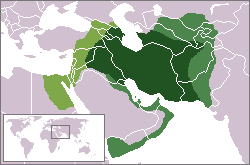Sassanid Empire
last pre-Islamic Iranian empire (224–651 AD) From Wikipedia, the free encyclopedia
Remove ads
The Sassanid Empire, or Sassanian Dynasty,[1] is the Persian dynasty that lasted from 224 to 651 AD.[2][3]

The Sassanid Empire, which succeeded the Parthian Empire, was recognized as one of the two great powers in Western Asia, alongside the Roman Empire and later the Byzantine Empire, for more than 400 years.
King of kings
The Sassanid dynasty was founded by Ardashir I when he defeated the last Parthian (Arsacid) king, Artabanus IV, and ended when the last Sassanid Shahanshah (King of Kings), Yazdegerd III (632–651), lost a fourteen-year struggle to drive out the early Arab Caliphate, the first of the Islamic empires.
The Sassanid Empire's traditional territory included what are now Iran, Iraq, Armenia, Afghanistan, Egypt and eastern Turkey and parts of Syria, Pakistan, Caucasia, Central Asia and Arabia.
The Sassanid era is considered to be one of the most important and influential historical periods in Iran. In many ways; the Sassanid Empire saw the highest achievement of Persian civilization and was the last great Persian empire before the Muslim conquest and the adoption of Islam.
Sassanid Persia influenced the Roman Epmire considerably,[4]p109 and the Romans reserved for the Sassanid Persians the status of equals. The Roman Emperor wrote letters to the Persian Shahanshah, which were addressed to "my brother". The Sassanids' cultural influence extended far beyond the empire's territorial borders by reaching as far as Western Europe,[5] Africa,[6] China and India and played a prominent role in the formation of both European and Asiatic mediaeval art.[7]
This influence carried forward to the early Islamic world. The Sassanids' unique aristocratic culture transformed the Islamic conquest of Iran into a Persian renaissance.[5] Much of what later became known as Islamic culture, architecture, writing and other skills were borrowed from the Sassanids and spread throughout the broader Muslim world.
Remove ads
Religion
The Sassanids began making the empire more Iranian after the fall of the Parthians by implementing and promoting Zoroastrianism in their kingdom.
Zoroastrianism was the backbone and state religion of the Sassanid Empire. It was one of the first monotheistic religions and so the Sassanids believed in one god. The traditional Zoroastrian scripture, Avesta, was originally orally preserved in Avestan, a now-extinct language. However, the Sassanids were the first people to write the Avesta down wrote did so in an Aramaic script. In addition, many of the those who did not follow the Zoroastrianism faith were persecuted by the government.
Remove ads
Decline
In the spring of 632, a grandson of Khosrau I, Yazdegerd III, who had lived in hiding, ascended the throne. The same year, the first raiders from the Arab tribes made their raids into Persian territory and were united by Islam. Years of warfare had exhausted both the Byzantines and the Persians. Also, the latter were further weakened by economic decline, heavy taxation, religious unrest, rigid social classes, the increasing power of the provincial landholders and a rapid turnover of rulers. Those factors made the Islamic conquest of Persia easier than if it had been attempted earlier.
The Sassanids never mounted a truly effective resistance to the pressure that was applied by the Muslim conquests.
Chronology
226–241: Reign of Ardashir I:
- 224–226: Overthrow of the Parthian Empire.
- 229–232: War with Rome.
- Zoroastrianism is revived as official religion.
- The collection of texts known as the Zend Avesta is assembled.
241–271: Reign of Shapur I:
- 241–244: War with Rome.
- 252–261: War with Rome. Capture of Roman Emperor Valerian.
- 215–271: Mani, founder of Manichaeism.
271–301: A period of dynastic struggles.
283: War with Rome. Romans sack Ctesiphon.
296-8: War with Rome. Persia cedes five provinces east of the Tigris to Rome.
309–379: Reign of Shapur II "the Great":
- 337–350: First war with Rome with relatively little success.
- 359–363: Second war with Rome. Rome returns trans-Tigris provinces and cedes Nisibis and Singara to Persia.
387: Armenia partitioned into Roman and Persian zones.
399–420: Reign of Yazdegerd I "the Sinner":
- 409: Christians are permitted to publicly worship and to build churches.
- 416–420: Persecution of Christians, as Yazdegerd revokes his earlier order.
420–438: Reign of Bahram V:
- 420–422: War with Rome.
- 424: Council of Dad-Ishu declares the Church of the East independent of Constantinople.
- 428: Persian zone of Armenia annexed to Sassanid Empire.
438–457: Reign of Yazdegerd II:
- 441: War with Rome.
- 449-451: Armenian revolt.
482-3: Armenian and Iberian revolt.
483: Edict of tleration granted to Christians.
484: Peroz I defeated and killed by the Hephthalites.
491: Armenian revolt. Armenian Church repudiates the Council of Chalcedon:
- Nestorianism becomes dominant the Christian sect in Sassanid Empire.
502-506: War with Constantinople.
526-532: War with Constantinople.
531–579: Reign of Khosrau I, "with the immortal soul" (Anushirvan)
540–562: War with Constantinople.
572-591: War with Constantinople. Persia cedes much of Armenia and Iberia to Constantinople.
590–628: Reign of Khosrau II
603–628: War with Constantinople. Persia occupies Byzantine Mesopotamia, Syria, Palestine, Egypt and the Transcaucasus but is driven to withdraw to pre-war frontiers by Byzantine counter-offensive.
610: Arabs defeat a Sassanid army at Dhu-Qar.
626: Unsuccessful siege of Constantinople by Avars and Persians.
627: Byzantine Emperor Heraclius invades Assyria and Mesopotamia. Decisive defeat of Persian forces at the battle of Nineveh.
628–632: Chaotic period of multiple rulers.
632–642: Reign of Yazdegerd III.
636: Decisive Sassanid defeat at the Battle of al-Qadisiyyah during the Islamic conquest of Persia.
642: Final victory of Arabs when the Persian army destroyed at Nahavand (Nehavand).
651: The last Sassanid ruler, Yazdegerd III, is murdered at Merv, now in Turkmenistan, ending the dynasty. His son Firuz and many others go into exile in China.
Remove ads
Notes
References
Other websites
Wikiwand - on
Seamless Wikipedia browsing. On steroids.
Remove ads
